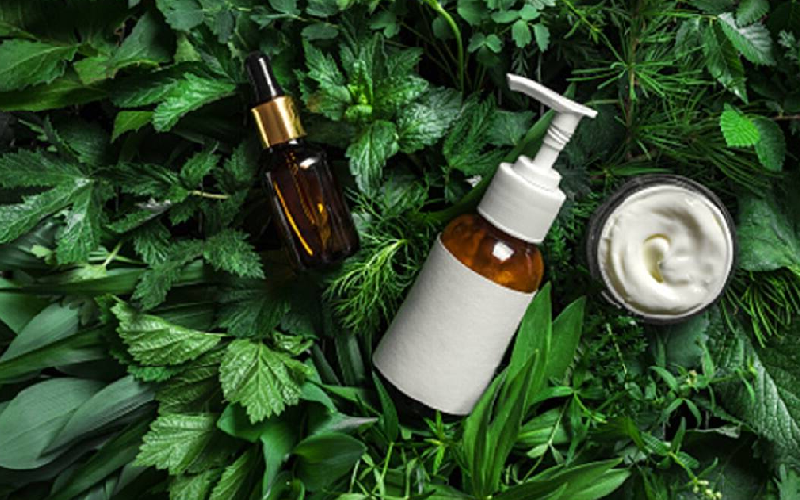
Sustainable skincare is not only a trend that’s transforming the face of the beauty industry, but is also creating a harmonious relationship between our skin and the environment. Here we aim to elucidate what sustainable skincare truly means and why it is a concept we should embrace.
We’ve all heard of ‘Farm to Table’ in the food industry, promoting locally sourced, organic produce that’s not only better for our health but also for our planet. Taking a leaf from the same book, the skincare industry has adopted the ‘Farm to Face’ approach, a practice that emphasizes the use of all-natural, ethically sourced ingredients from farms instead of chemical-laden, synthetic materials.
Contents
The Rise of Sustainable Skincare
The beauty and skincare industry has seen a transformative shift over the past few years. With growing consumer consciousness towards the health of our planet and the desire for cleaner, healthier products, the concept of sustainable skincare has taken center stage.
Sustainable skincare didn’t appear overnight; it has been a gradual shift fueled by increasing awareness about the environmental impacts of our choices and the harmful effects of many traditionally used skincare ingredients. This rise can be attributed to various factors, from the growing environmental consciousness of consumers to the evolution of technology that supports sustainable practices.
Traditional Skincare Industry and Its Impact
Historically, the skincare industry hasn’t been particularly eco-friendly. Traditional skincare products often contain synthetic chemicals, some of which are not only potentially harmful to the skin but also to the environment. The production of these ingredients can lead to pollution, biodiversity loss, and the unnecessary use of valuable natural resources. Furthermore, the widespread use of non-recyclable plastic packaging in the beauty industry has contributed significantly to the global plastic waste crisis.
The Shift Towards Sustainability
Amidst these concerns, a transformation began. As consumers started becoming more conscious of their choices and their impact on the environment, demand for sustainable, ‘clean’ skincare grew. This consumer-driven shift led many brands to reevaluate their sourcing, manufacturing, and packaging processes, aligning themselves with more eco-friendly and ethical standards. This shift was further backed by advancements in technology and science that made it possible to create effective skincare products using natural, sustainable ingredients.
Definition of Sustainable Skincare
Sustainable skincare refers to products that are created with a minimal environmental impact. This includes the sourcing and farming of ingredients, the manufacturing process, and the disposal of the product after use. These products are typically made from natural, organic ingredients that are ethically sourced and cruelty-free.
They also use eco-friendly packaging that’s either recyclable or biodegradable. The aim is to create a product that’s as good for the earth as it is for your skin. The idea is not just to consume responsibly, but also to contribute positively to a more sustainable world [1].
Importance of Sustainable Skincare
The importance of sustainable skincare lies in its potential to minimize our ecological footprint while promoting healthier skin. By opting for products that are ethically sourced, made from natural ingredients, and housed in eco-friendly packaging, we contribute to the health of our planet and ourselves. Sustainable skincare also supports fair trade, local sourcing, and cruelty-free testing, making it an all-round beneficial choice.
Consumers’ Growing Awareness and Demand
The rise of the internet and social media has been pivotal in fostering a new era of informed consumers. Easy access to information has allowed people to research and understand the impact of their skincare choices, both on their skin and the environment.
This growing awareness and the resultant demand have played a significant role in driving the shift towards sustainable skincare. A 2022 survey by IBM indicated that nearly 6 in 10 consumers were willing to change their shopping habits to reduce environmental impact. As this trend continues, we can expect the demand for sustainable skincare to rise even more, shaping the future of the skincare industry.

Understanding the Concept: “From Farm to Face”
Just as the ‘farm to table’ movement revolutionized the food industry, the ‘farm to face’ concept is making waves in skincare. As we delve into this term, we’ll uncover how it ties into the sustainable skincare movement and why it matters.
Explanation of “From Farm to Face”
‘Farm to Face’ is a term that embodies the journey of skincare ingredients from their agricultural origins right to your skincare routine. It’s about using skincare products that are not only formulated with natural, farm-grown ingredients, but also with a commitment to sustainable farming practices, ethical sourcing, and transparent supply chains. The goal is to create a skincare product that is as close to nature as possible, bringing the wholesome goodness of farm-grown ingredients directly to your skin [2].
The Role of Organic Farming in Skincare
Organic farming plays a significant role in the ‘Farm to Face’ concept. It focuses on growing ingredients without the use of synthetic pesticides and fertilizers, which not only ensures that the final skincare products are free from potentially harmful residues but also reduces environmental pollution. Organic farming practices also support biodiversity and healthier soils, leading to better quality ingredients that offer more potent benefits for your skin.
Impact on Product Quality and Efficacy
The ‘Farm to Face’ approach has a profound impact on the quality and efficacy of skincare products. By prioritizing organic, sustainably grown ingredients, these products often contain higher levels of beneficial compounds, like antioxidants, and fewer harmful residues.
This means they not only nourish and protect your skin but also align with a broader commitment to environmental and ethical responsibility. Furthermore, knowing the origin of the ingredients instills a sense of trust and transparency between the consumer and the brand, enriching the overall skincare experience [3].

Key Elements of Sustainable Skincare
To fully appreciate the depth and breadth of sustainable skincare, it’s essential to understand its key elements. The term ‘sustainable’ isn’t just a buzzword; it encompasses several aspects, from ingredient sourcing and formulation to packaging and disposal.
Natural and Organic Ingredients
One of the most significant aspects of sustainable skincare is the use of natural and organic ingredients. These ingredients, sourced from plants and minerals, are not only gentler on our skin but also kinder to the earth. When farmed organically, they’re grown without synthetic pesticides and fertilizers, reducing soil and water pollution and promoting biodiversity.
Ethical Sourcing and Fair Trade
Ethical sourcing ensures that ingredients are obtained in a responsible and sustainable way, with the workers involved in the farming and production process treated fairly and paid appropriately. Fair trade practices also play a significant role here, ensuring equitable trade conditions and contributing to sustainable development for marginalized producers and workers.
Environmentally-Friendly Packaging
Sustainable skincare also looks at the lifecycle of the product, and this includes packaging. A truly sustainable product should be housed in recyclable or biodegradable packaging, reducing waste and the demand for new plastic production. Some brands even offer refillable options to further cut down on waste.
Cruelty-Free Testing
A key component of sustainable skincare is ensuring that products are cruelty-free. This means that products and their ingredients are not tested on animals at any point during the production process. The focus here is on ethical treatment of all beings and the use of alternative, humane testing methods [4].
Benefits of Sustainable Skincare
Sustainable skincare goes beyond promoting healthy skin; it positively impacts various aspects of our life and the world we inhabit. Let’s explore these benefits in detail, touching on the environment, local communities, and the individual health and wellness advantages.
Benefits for the Environment
The first and perhaps most significant benefit of sustainable skincare is its positive impact on the environment. By using natural, organic ingredients, we reduce the demand for synthetic chemicals, which often lead to pollution during their production and disposal. Ethically sourcing these ingredients promotes biodiversity and healthier soils. Moreover, sustainable packaging reduces waste and our reliance on fossil fuels, while cruelty-free testing eliminates unnecessary animal suffering.
Benefits for Local Communities
Sustainable skincare also provides tangible benefits for local communities. Ethical sourcing and fair trade practices ensure that the people involved in the production of these products are treated fairly, paid adequately, and work in safe conditions. This can help uplift local economies, particularly in developing nations where many natural ingredients are sourced.
Health and Wellness Benefits for Users
Finally, sustainable skincare has distinct advantages for the end user. Products formulated with natural and organic ingredients are often gentler and healthier for our skin. They’re typically free from harsh chemicals, synthetic fragrances, and artificial colors, which can cause irritation and other skin issues [5].
Many users also find that knowing their products are ethically sourced and environmentally friendly adds a level of mindfulness and satisfaction to their skincare routine. After all, when we nurture our skin with products that are good for the earth, we’re not only beautifying ourselves but also contributing to a greater cause.

Challenges in Sustainable Skincare
While the shift towards sustainable skincare is undoubtedly positive, it’s not without its hurdles. From production costs to consumer skepticism, let’s shed light on the challenges that this nascent industry faces.
Higher Costs of Production and Pricing
One of the most prominent challenges is the cost associated with sustainable practices. Organic farming, ethical sourcing, eco-friendly packaging, and alternative testing methods can all increase the production costs for a skincare brand. As a result, sustainable skincare products often come with a higher price tag, which can deter some consumers.
Greenwashing in the Beauty Industry
Greenwashing – the practice of making misleading claims about the environmental benefits of a product or service – is another significant challenge in the sustainable skincare industry. Some brands use vague or deceptive terms like ‘green’, ‘natural’, or ‘eco-friendly’ without substantiating these claims. This can mislead consumers and dilute the value of genuinely sustainable skincare products.
Consumer Skepticism and Misinformation
A related challenge is consumer skepticism. With so much greenwashing occurring, it’s no surprise that many consumers are wary of sustainable skincare claims. This skepticism is compounded by a lack of standardization in terms like ‘natural’, ‘organic’, and ‘sustainable’, which can be interpreted in various ways. Misinformation or lack of information about the efficacy of natural ingredients compared to their synthetic counterparts can also make consumers hesitant to switch to sustainable products.
References
[1] Farm to face: Is this the next trend in natural beauty?
[2] What is organic skin care and how is it different?
[3] 4 Companies Making Skincare Holistic, Organic And Sustainable
[4] Sustainable changes in beauty market trends focused on the perspective of safety
[5] Trends in Clean, Sustainable, and Green Skin Care, Cosmetics







